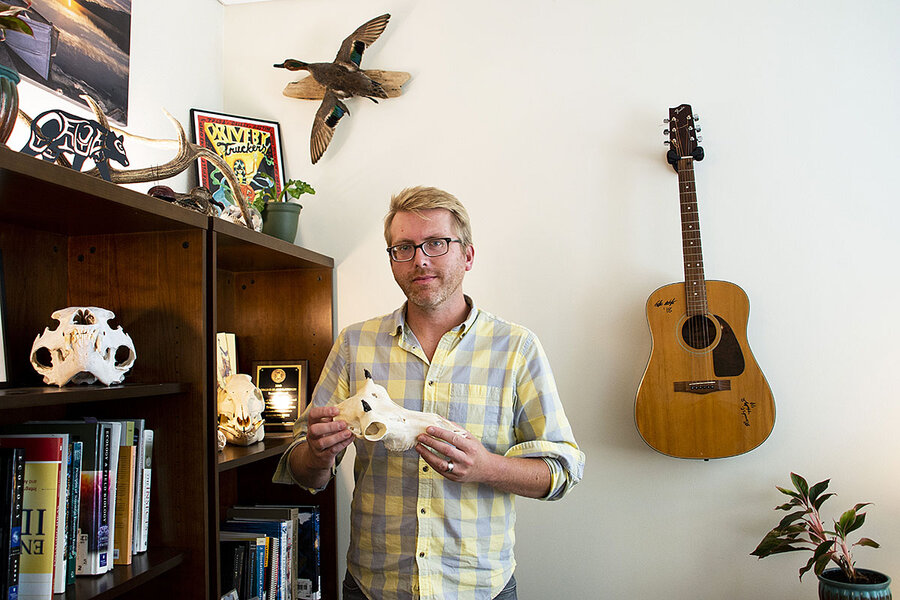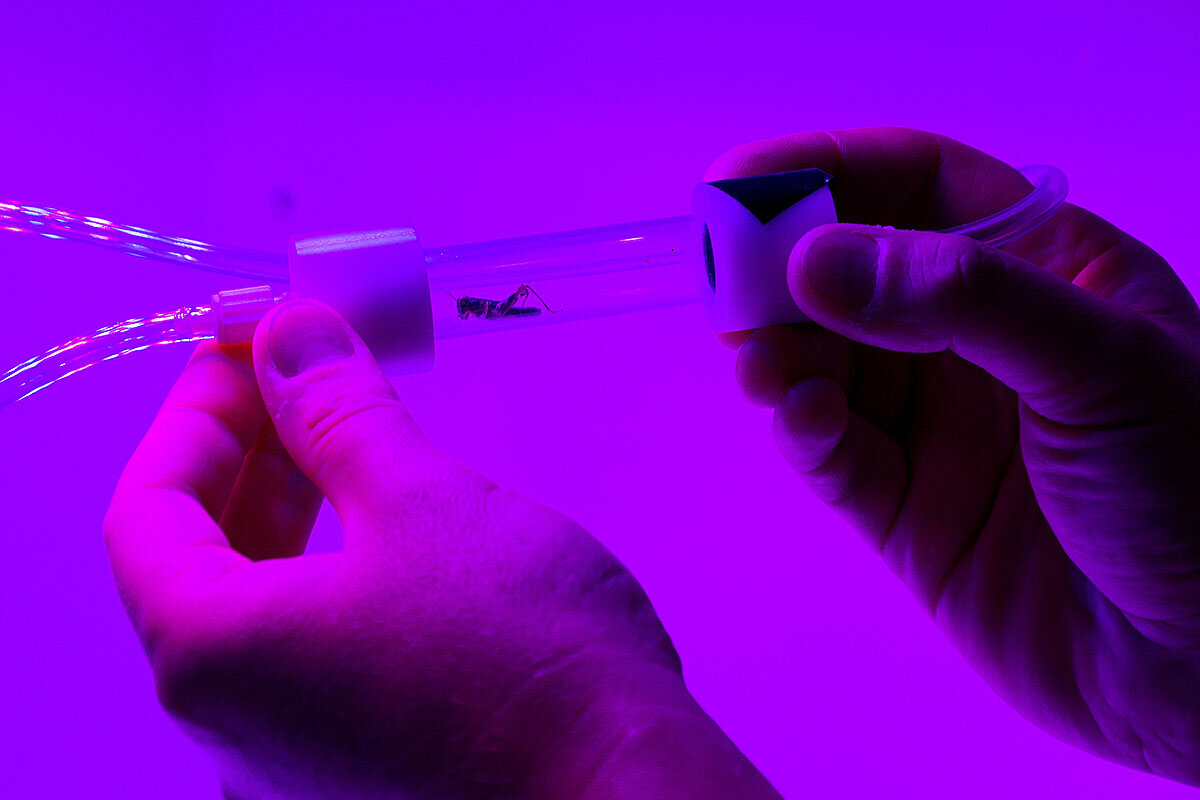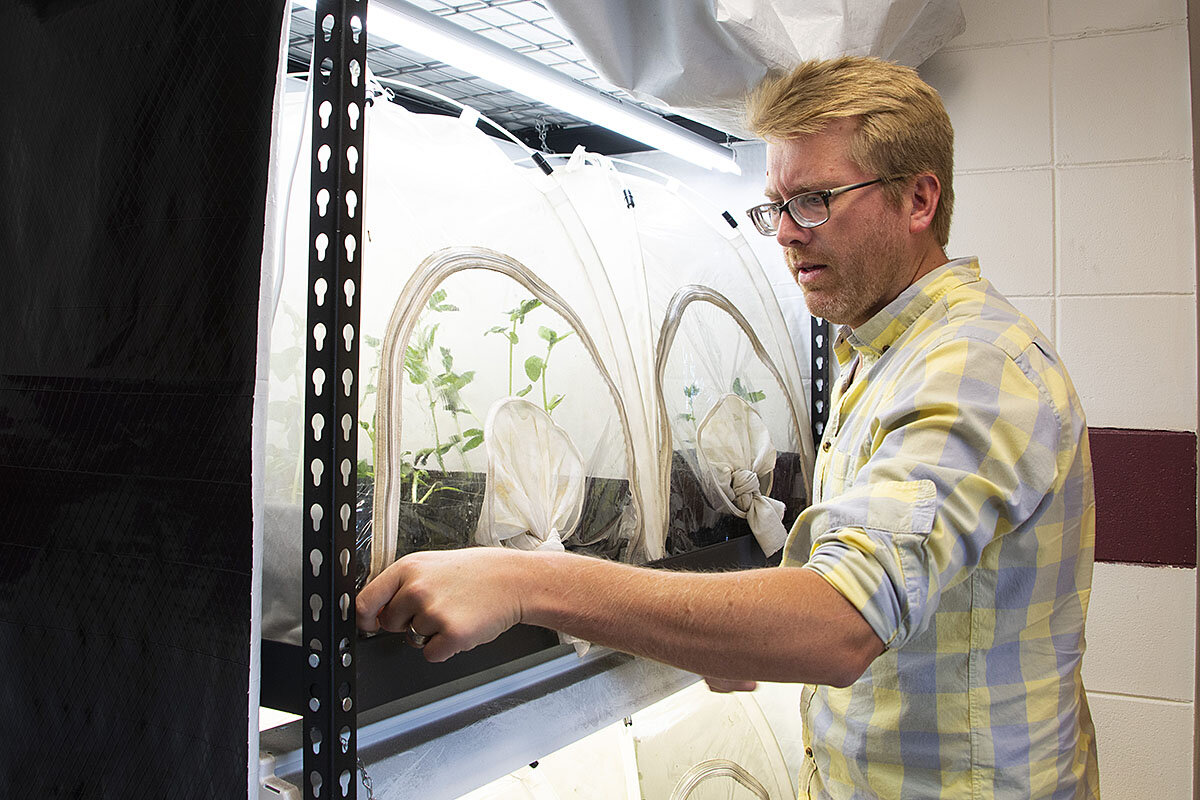For those about to rock: The scientist who played AC/DC for ladybugs
Loading...
| Starkville, Mississippi
When his mom told him dandelions could grow anywhere, 5-year-old Brandon Barton wasn’t about to take her word for it. So he sprinkled dandelion seeds across the hood of her car. Not surprisingly, they didn’t grow.
Now, all grown up and an ecologist at Mississippi State University, Dr. Barton continues to test out seemingly silly questions about how the biological world works. In the name of science, he has played rock music to insects, watched hog carcasses rot, and dug around in wolf excrement.
But it isn’t without rhyme or reason. Dr. Barton’s research focuses on how one tweak in an ecosystem can trigger a whole cascade of changes. His approach marries simple curiosity and seemingly goofy questions with the scientific method in order to explore some of the most relevant environmental questions of the day. This kind of offbeat research offers a lens into how scientists drive new ways of thinking about the world.
Why We Wrote This
Where do ideas come from? For scientists like Brandon Barton, serious inquiry often starts with silly questions. First in an occasional series on the people and stories driving discovery.
“He does work that has a ‘gee-whiz’ aspect to it,” says Oswald Schmitz, Dr. Barton’s Ph.D. adviser at Yale University. “But it actually has more profound implications.”
For those about to rock
One of Dr. Barton’s quirkier experiments involved playing AC/DC to ladybugs. Inspired by the band’s 1980 hit “Rock and Roll Ain’t Noise Pollution,” he aimed to test how various organisms would respond to rock ’n’ roll.
Ladybugs are part of a food web important to farmers. The little red beetles chow down on aphids, which suck the sap out of plants, often affecting the growth of crops.
So Dr. Barton and a team of graduate students blasted AC/DC, Lynyrd Skynyrd, Guns N’ Roses, and other bands at 95 to 100 decibels into a chamber as ladybugs and aphids went about their business on soybean plants inside. He speculated that if the ladybugs responded poorly to the tunes, more aphids would survive, and the crops wouldn’t grow as well. And that’s exactly what happened.
While rock ’n’ roll isn’t really a concern in farmers’ fields or most natural spaces, tractors are pretty loud (approximately 100 decibels), and humans make a lot of noise with other machinery, too. The novelty of the AC/DC-inspired study garnered a lot of public attention. But the U.S. Department of Agriculture took a more practical interest and agreed to fund another noise pollution study in Dr. Barton’s lab.
Now, Dr. Barton and his students are exploring whether sound could be used to keep grasshoppers from eating protein-rich grasses meant for cattle. They are experimenting with particular frequencies that prompt the insects to opt for high carbohydrate plants instead.
“I’m personally less interested in the application,” Dr. Barton says. What intrigues him is how human sounds, artificial light, and other anthropogenic alterations might have cascading effects throughout an entire ecosystem.
“I think right now people aren’t really paying a lot of serious attention to these kinds of environmental factors, and maybe they should,” says Dr. Schmitz, “and I think Brandon is providing some proof of concept for that.”
Dr. Barton is not alone, though, Dr. Schmitz adds. “He’s part of a vanguard that is showing that we need to take these things more seriously.”
Thinking outside the lab
On the wall of Dr. Barton’s office is a duck with backward feet – a high-school taxidermy project. The first deer he ever shot hangs in his laboratory down the hall. He stuffed and mounted it in his dormitory as an undergraduate student. “People were not happy,” he says, chuckling at the memory.
Growing up in Idaho, Dr. Barton learned to hunt and fly-fish at an early age. “I was the kid that just lived for fishing,” he says, and that shaped his interest in food webs and his keen observational skills – which continue to serve him as an ecologist.
While hiking in the remote wilderness along the Oregon-Idaho border in 2017, Dr. Barton spotted something that most people wouldn’t dare look closely at: wolf poop. It didn’t look like any wolf scat he’d ever seen before. It was filled with grasshopper exoskeletons. The idea that wolves might munch on these insects seemed preposterous – but intrigued Dr. Barton. After further research, he and several colleagues published the findings in September.
“Dr. Barton is outstandingly creative,” says Bill Ripple, an ecologist at Oregon State University best known for his research on the role of the gray wolf in shaping food webs and landscapes in North America. He is also a co-author on the wolf-grasshopper paper. “He just gets outside and starts noticing.”
Practical jokes
Some experiments have earned Dr. Barton a sort of renown among his co-workers.
“Everybody jokes about Brandon’s dead pigs,” says his department head, Angus Dawe.
Dr. Dawe is referring to the time that Dr. Barton set out to study what happens when a bunch of animals drop dead. To do that, he piled 6,000 pounds of feral hog carcasses in the forest, set up cameras and insect traps, and waited. As the pigs rotted, the researchers tested, measured, and counted everything, from the leaf litter and soil to the maggots, vultures, and other scavengers.
He hoped to shed light on how the landscape and ecosystem respond to mass mortality events – when, say, thousands of antelopes drop dead, hundreds of dead whales wash up on a beach, or millions of animals are killed due to wildfires, as is happening today in Australia.
Dr. Barton does worry that his research might be perceived by some as novelty science rather than relevant research.
“It’s not all just silly things to make people smile like AC/DC and wolf poop and piles of dead animals,” he says. The goal is for the public to benefit in some way from the answer, and for scientists to be able to build upon what he’s done.
But most of all, Dr. Barton and his students have to find it interesting, he says. “We don’t get paid super well. We work too many hours. It’s often thankless. Some people hate what we’ve done. So you can’t be doing this for the glory or the money. It has to be some sort of intrinsic passion to know the answer.”
And that enthusiasm is “infectious,” says Dr. Dawe. “It lets me get excited about the work without it being something I’d ever want to do myself.”








